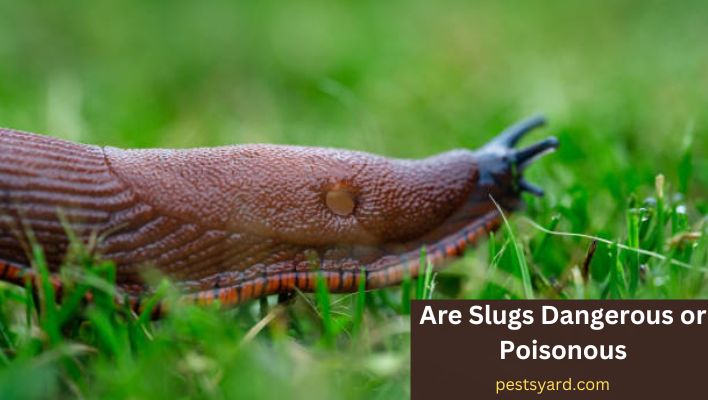While slugs are just vegetable-eating creatures, they can cause major damage to your garden. People often wonder if slugs are dangerous and whether or not they should be exterminated.
Most of the time, slugs are not. But they can threaten your garden or lawn during their mating season. Slugs like to eat plants, and if they get into pots where they find something tasty, the sliminess makes it nearly impossible for you to remove them without damaging the contents. Check here on how to stop slugs from climbing pots naturally.
While slugs are usually considered garden pests, they do pose some threats to pets and humans. A closer look at these furry garden pests reveals their dangers in a different light.
Slugs are not dangerous
Slugs are one of the most common pests that gardeners face. However, these little animals are harmless and are most likely out to only eat plants.
Slugs eat about anything they can find, including leaves, flowers, fruits, young plants, and even dead insects. Many gardeners feel that slugs are beneficial as they help control pest insect populations by eating their larvae, but this is not true.
Slugs can also carry disease organisms like bacteria or fungi, which could damage your plants if they become infected. Some species of slug can cause allergic reactions in humans if they come into contact with their skin or eyes. However, there have been no recorded cases of this happening with normal garden slugs.
Slugs are not dangerous to your dog or cat. They are common garden pests and can cause damage to plants, but they are not a threat to your pet. In some cases, slugs are beneficial in the garden because they eat many insects that cause pests.
However, slugs are dangerous and can destroy your garden when not controlled. They are the second most common type of snail in the world. They can cause a lot of damage to your garden, and they can also transmit diseases like Angiostrongylus. Here is how to get rid of slugs from your garden and plants.
Touching a slug with your bare hands can be dangerous
Touching a slug with your bare hands can be dangerous. Slug slime contains many proteins that can cause an allergic reaction in some people, and there are also some diseases that the slug may carry that you could get if you touch it.
You are more likely to get your hands or arms infected if you touch a slug with your bare hands. They carry parasites such as rat lungworm or Angiostrongylus cantonensis which can cause severe health issues.
Ingesting this slime by mistake can cause several health problems, including diarrhea and vomiting. If you ingest the slime, you should seek medical attention immediately. Wash your hands when you pick slugs with them to prevent this from happening.
If you want to be on the safe side, there are ways to handle slugs without getting sick or contracting any diseases safely. The best way to handle them is with a pair of gloves and a container, or use hand sanitizer immediately after picking them up.
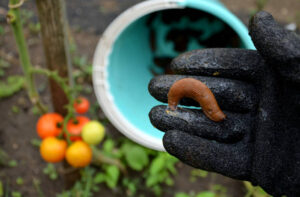
Slug mucus is not toxic or harmful
Slug mucus is a protective secretion the slug produces to keep it hydrated and prevent dehydration. It also helps the slug move around and regulates body temperature.
Slug mucus is not made from harmful materials but rather from a substance called slime, produced by slugs for use as a lubricant in their bodies. The mucus comprises water, proteins, salts, and other small molecules that help slugs regulate their body temperatures and keep them hydrated.
It also acts as an anti-microbial agent to help prevent infection from bacteria and viruses that would otherwise cause sickness or death if left untreated. So while the slime might be gross to look at, it’s doing all kinds of good stuff for your favorite creepy crawly pests.
However, they can be irritating if you’re allergic to them. If you’re allergic to slug slime, you might experience skin irritation, coughing, sneezing, or wheezing after touching it. If you get slug slime on your skin, wash it off immediately with soap and water.
What would happen if you eat a slug?
If you eat a slug, your body will process it as an animal protein when cooked properly. In other words, you’ll get the same amino acids and nitrogenous compounds that you would get from eating any other animal protein.
The main difference between eating a slug and eating meat is that you won’t get the same amount of calories from the slug as you would from meat. For example, one ounce (about 25 grams) of beef contains about 200 calories, while one ounce (about 25 grams) of slug meat will only contain about 100 calories.
So they are mostly harmless to humans but can still cause problems if they’re not properly prepared. If you’re planning on eating a slug, it’s important to be aware of the risks and take precautions to avoid getting sick.
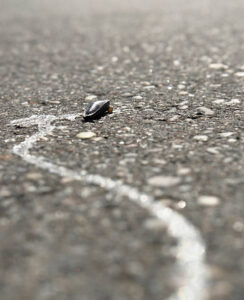
Dried-up slug slime trails are not dangerous
Slugs are great at making slime. It’s their job. But they also tend to follow it everywhere and leave behind a trail of goo wherever they step. This goo is what we call dried-up slug slime and can be found on lawns and sidewalks worldwide.
Dried-up slug slime is harmless to humans, pets, and other mammals and even beneficial to the environment! It’s an important food source for many insects that help to break down organic waste in the soil, so leaving it behind can help maintain a healthy ecosystem.
The slime on a slug’s trail is just what they squirt out to communicate with each other or something. It helps them move around to find food and, unfortunately, attracts predators in some cases.
What do slugs eat
Slugs can eat almost anything, but they’re particularly fond of soft leaves and fruits. They also like to eat snails, earthworms, and other slugs. They eat various foods, including plants, animal poop, and dead animals.
Slugs are primarily herbivores, which means that they primarily eat plants. However, slugs can also consume other things, like insects and algae.
They can eat anything from algae in ponds to leaves on trees, but their favorite foods tend to be green algae, which is found in freshwater habitats or on the surface of streams and lakes. Slugs also love eating mosses, ferns, and lichens with their long tongues.
Slugs are also known for eating dead plant material. This can include stems, leaves, and even plant parts, such as flowers or seeds, which can damage your plants. If you find slugs in your garden, it is best to get rid of them as they can be destructive while going about their activities.
Are leopard slugs dangerous?
Leopard slugs are considered invasive species in many areas of the world and have the ability to cause significant damage to gardens and crops. They can also be a nuisance to homeowners, who may want to keep them out of their yards.
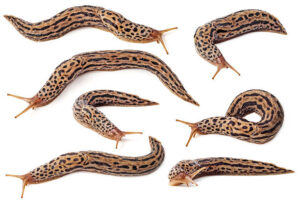
However, these pests are not dangerous to humans. The leopard slug is a type that feeds on algae, fungi, and bacteria. They can be found in a lot of different places, including gardens, meadows, and forests. Because they live in high-humidity areas like these, they’re often preyed upon by larger animals like birds or frogs.
Leopard slugs are not poisonous to humans; they’re more likely to cause a skin rash if you touch them than anything else. If you do come into contact with one of these snails and it feels like it’s biting you, the best thing to do is wash it off immediately with soap and water.
If your skin starts to swell or become red or painful after contacting the snail (or if you find one on yourself), go see a doctor immediately.
Are banana slugs poisonous?
Banana slugs are not poisonous, but the ones that are can cause a variety of health problems. They have a slime trail and can give you a rash if you touch them, but they’re harmless. If you find yourself in an area where banana slugs are common, you should be aware of the risks and take appropriate precautions.
While they may look like strange, slimy creatures, slugs are gastropod mollusks; they’re kind of like snails, except for the fact that they don’t have shells. They are a good source of protein and snacks when cooked properly.
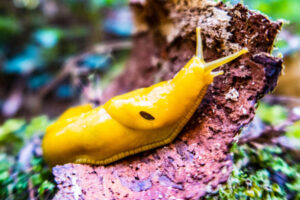
In general, banana slugs are not poisonous to humans. However, some species of slug may release toxins. These toxins can cause nausea and vomiting, as well as diarrhea and cramps in humans who eat them, especially when not properly cooked.
Suppose you encounter a group of these slugs in your yard. In that case, it’s a good idea to wear gloves and latex gloves over them when handling them so that you don’t accidentally come into contact with any secretions on your hands or clothes (you should wash those items immediately).
Are slugs dangerous to dogs and cats?
Slugs are common garden and yard pests but are not dangerous to dogs or cats.
Slugs are generally not considered a threat to the health of your dog or cat. They may carry diseases that may cause harm when ingested by your pests. Mostly, they will walk away on their own if they feel threatened by the presence of dogs or cats.
However, if your dog or cat has ingested a slug, it is possible to cause illness in your pet. Suppose you are concerned about the potential health impacts of slugs on your dog or cat. In that case, you should consult a veterinarian or other animal-care professional before attempting to kill them.
Where do slugs live?
Slugs are invertebrates, so they don’t have a home. Slugs are usually found on land and in damp areas, but some species can also be found in water. They live in wet places, like your garden and flowerbeds, and you might even find one under the deck of your house (if you have a deck).
Slugs live in damp places with a lot of moisture, like forests and gardens with lots of plants to eat or shelter in. Also, cracks in a brick wall or the bottom of a potted plant are great places to find slugs. Slugs are also great at hiding in small spaces, so they can be found under rocks and soil.
Slugs can also live in trees or shrubs. If you’re wondering where slugs live, their habitat is the same as any other animal: land and water.
